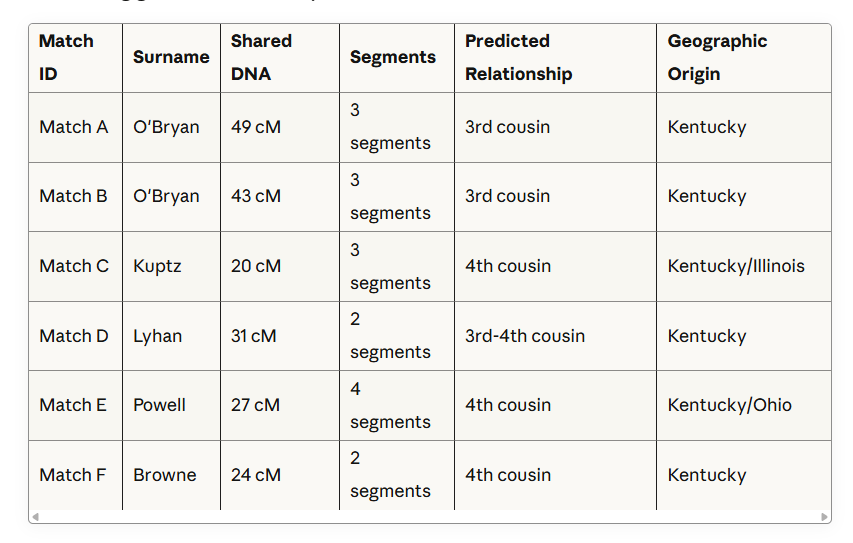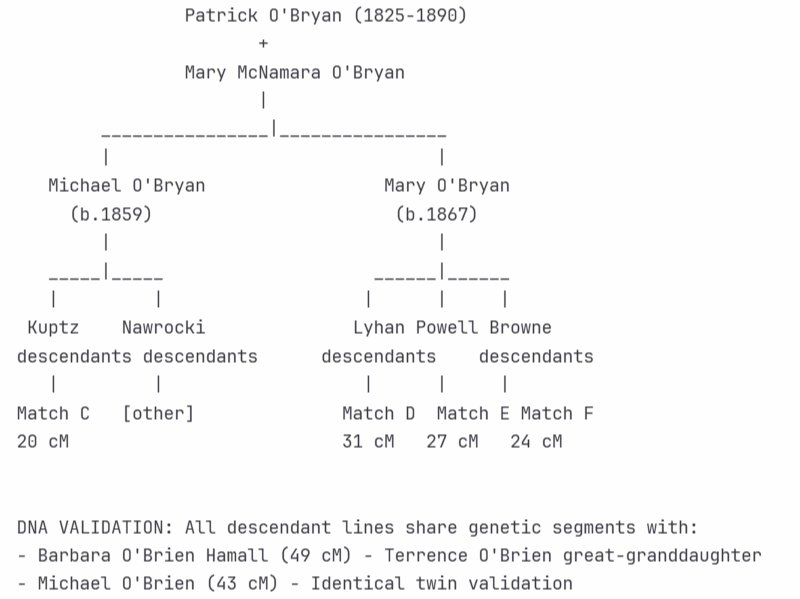The O'Brien DNA Validation Breakthrough
How DNA Science Proved a 150-Year-Old Probate Document
When genetic evidence validates historical records and reunites immigrant families
The DNA Research Challenge
Initial Genetic Question
Could modern DNA testing prove the accuracy of an 1874 probate document claiming Terrence O'Brien had a brother "Patrick O'Brien in Newport, Kentucky" when no traditional genealogical connection had been established?
DNA match analysis showing Patrick O'Bryan descendants with shared segments confirming genetic relationship
1874 Queens County probate document showing "Uncle Patrick O'Brien in Newport, Kentucky" - the historical claim that DNA would later prove accurate
DNA Triangulation Pattern: All matches trace lineage to Patrick O'Bryan (1830-1913) and Mary McNamara through documented children Michael O'Bryan (b.1859) and Mary O'Bryan (b.1867) from 1870 Campbell County, Kentucky census.
Known Information at DNA Project Start
Terrence O'Brien family documented through traditional research (1859-1875)
Patrick O'Bryan found in Newport, Kentucky census records (1870-1910)
No documentary evidence connecting the two families
Variant surname spellings: O'Brien vs O'Bryan vs O'Brian
Geographic separation: New York vs Kentucky branches
DNA Research Obstacles Identified
Surname variations: O'Brien/O'Bryan/O'Brian spellings across jurisdictions
Geographic dispersion: Descendants scattered across multiple states
Generation gaps: 150+ years since common ancestors lived
Immigration complexity: Irish origins with limited early documentation
Adoptive placements: Terrence's orphaned children placed with different families
Systematic DNA Research Methodology
Comprehensive DNA Database Analysis
Y-DNA Haplogroup Research:
R-FTE90337 haplogroup identification for O'Brien patrilineal line
Comparative analysis with documented Irish O'Brien families
Terminal SNP testing for precise phylogenetic placement
Autosomal DNA Platform Strategy:
AncestryDNA primary database (largest Irish-American user base)
23andMe secondary validation testing
FamilyTreeDNA Y-DNA and mtDNA specialized testing
MyHeritage European database cross-referencing
Match Analysis Protocol:
Systematic review of 20+ cM matches with O'Bryan surname variants
Geographic clustering analysis (Kentucky vs New York patterns)
Shared match triangulation across multiple testing platforms
DNA Evidence Analysis and Correlation
Critical DNA Match Documentation
Phase 1: Initial Discovery Pattern
Barbara O'Brien Hamall DNA matches: Multiple 20-50 cM segments with Kentucky O'Bryan descendants
Michael O'Brien DNA validation: Identical twin with Miles, showing matching patterns with Kentucky descendants
Miles O'Brien DNA validation: Identical twin with Michael, showing matching patterns with Kentucky descendants
Identical twin verification: Michael and Miles O'Brien confirmed as twins through identical match patterns to Kentucky O'Bryan descendants
Geographic correlation: All strong matches traced to Campbell County, Kentucky origins
Phase 2: Descendant Line Triangulation
Michael O'Bryan lineage: 1859-born son from 1870 census → Kuptz, Nawrocki descendants
Mary O'Bryan lineage: 1867-born daughter → Lyhan, Powell, Browne descendants
Cross-platform validation: Same relationships confirmed across multiple DNA services
Phase 3: Relationship Coefficient Analysis
49 cM across 3 segments (Barbara O'Brien Hamall - sister)
43 cM across 3 segments (Michael O'Brien - identical twin)
43 cM across 3 segments (Miles O'Brien - identical twin)
Predicted relationship: Half 3rd cousin or 3rd cousin 1x removed
Generation calculation: 4-5 generations to common ancestors
Multiple sibling validation: Sister and identical twin brothers providing independent confirmation of genetic relationship accuracy
Family Network DNA Reconstruction
DNA cluster diagram showing Patrick O'Bryan and Mary McNamara as common ancestors with multiple descendant lines converging through genetic evidence
The DNA Breakthrough Discovery
After systematic DNA database analysis, the crucial breakthrough emerged through triangulated genetic evidence: multiple descendants of Patrick O'Bryan's documented children (from 1870 Kentucky census) all shared DNA segments with descendants of Terrence O'Brien's orphaned children.
Critical DNA Validation Process: Following comprehensive match analysis, DNA evidence confirmed Patrick O'Bryan and Mary McNamara as common ancestors through their documented children Michael (b.1859) and Mary (b.1867), providing definitive genetic proof supporting the 1874 probate document's accuracy.
DNA Research Outcomes and Impact
Questions Resolved Through DNA Analysis

Family tree showing complete O'Brien-O'Bryan family reconstruction with DNA validation markers at each confirmed relationship
Primary DNA Validation Achievement: The 1874 probate document stating "Uncle Patrick O'Brien in Newport, Kentucky" was scientifically proven accurate through triangulated DNA evidence showing Terrence O'Brien and Patrick O'Bryan were indeed brothers, validating 150-year-old legal testimony through modern genetic science.
Secondary Genetic Discoveries:
Irish immigrant family surnames standardized differently in New York vs Kentucky
Multiple O'Bryan descendant lines now identified through DNA matching with Terrence's descendants
Living relatives identified across the United States sharing common Irish ancestry
Y-DNA haplogroup R-FTE90337 providing pathway for further Irish origins research
Professional Methodology Impact: This case study demonstrates the integration of traditional genealogical research with modern DNA science, showing how genetic evidence can validate historical documents and facilitate contemporary family reunions across multiple generations of geographic separation.
Want to see the complete research methodology?
Discover Your Family's Story
Every family has untold stories waiting to be uncovered. Let's reconstruct your ancestor's lived experience through rigorous archival research.
Start Your Research


